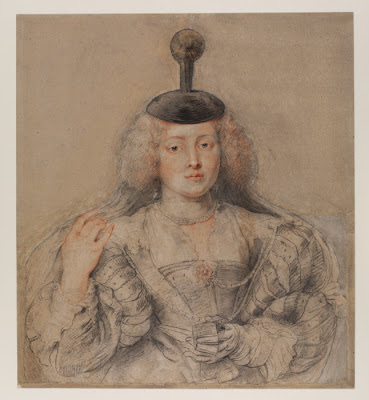 |
| Andy Warhol's dollar signs and flowers with Jeff Koons' puppy vases |
"I can't speak for the dead," Marla Prather, the exhibition's co-curator, told this reporter. But some artists among the living weren't sure they wanted to be in the Metropolitan Museum's sometimes superlative, sometimes problematic exhibit about Warhol's influence over the last half century. The show opens September 18.
Take Alex Katz. "I talked with Alex, and he was reluctant to be in the show," said Prather, pointing out that unlike most artists in the show, Warhol and Katz were contemporaries.
I.e., they could credibly argue over who had bragging rights to various practices.
 |
| Alex Katz, "Lita" |
Katz told Prather that "Warhol didn't influence
me, I influenced
him." Katz was referring to the flat background both artists favored, the double portrait, and the square portrait format, Prather said.
Both artists did a portrait of art collector Lita Hornick, but Katz's came first, and he claimed that he saw Warhol studying his version at Hornick's house before doing his own.
"Influence is a tricky thing," Prather remarked.
Eventually Katz came around to being in the show, and his "Lita" made the cut.
 |
| Warhol's Birmingham riots, based on a news photo |
Prather asked Vita Celmins, who is represented by her 1965 oil of a Time magazine cover, "On a scale of 1 to 100, what's your comfort level for being in the show?" Initially Celmins said 75%, but later asked Prather, "Can I change that to 50%?"
Another artist, whom Prather declined to name, told her that "his color came from Warhol, but he didn't want to be in the show because he didn't want to be in Andy's shadow."
He has a point.
The show has some 45 major works by Warhol. They range from his recreation of Brillo soap-pad boxes and paintings of Campbell's soup cans, to his silkscreen electric chair series and portraits of Liz and Jackie, to his screen tests of Nico, his dollar sign works, and his cow wallpaper. The show is worth seeing if only to catch the seminal moments in Warhol's career.
 |
| Ed Ruscha's Standard Oil gas station on fire |
But inevitably the other artists, represented by only one or sometimes a few works, seem like footnotes to the main event -- even those generally admired like John Baldessari and Ed Ruscha or those with several well-known works in the show like Jeff Koons, whose Hoover vacuum cleaners, sculpture of Michael Jackson with his chimpanzee, and identical puppy vases all make an appearance.
The show is organized around five themes: daily news, celebrity and power, queer (the curators' term) studies, something called "consuming images," which is an umbrella for appropriation, abstraction, and serial imagery, and finally "no boundaries," which deals with art as business, collaboration, and spectacle.
 |
| Tuymans' portrait of Condi Rice |
Plenty of outstanding works are on view aside from those by Warhol -- Luc Tuymans' portrait of then-Secretary of State Condoleezza Rice, for example.
And the show also satisfies some "what's the big deal" questions. Richard Prince, for example, has been much in the news lately because of a court case accusing him of infringing a photographer's copyright, and for those who haven't seen his blown-up photo of a photo of a cowboy taken from a tobacco ad -- well, here it is.
Sometimes the connection to Warhol is strained, which tends to minimize the other artists' work. For example, what do Warhol's neutral electric chairs have to do with Felix Gonzalez-Torres' intimate pile of candy, an allegorical tribute to his lover dead from AIDS? The theme of death, a constant in Western art, is quite independent of Warhol.
Still, in a cynical all-Warhol, all-the-time art world, "Regarding Warhol" is a reminder of how impressive his art is, how many of his works have become part of the cultural heritage, and how as he was continually remaking himself, he was also in many ways remaking art.
"Regarding Warhol: Sixty Artists Fifty Years," Metropolitan Museum of Art, Fifth Avenue at 82nd Street, September 18 to December 31
Text and photos (c) 2012 Laura Gilbert




















































